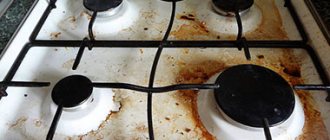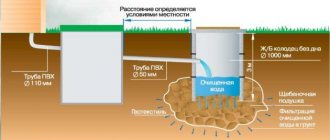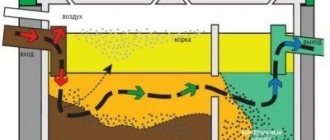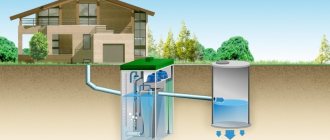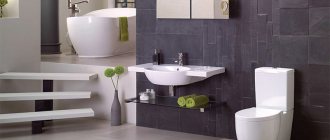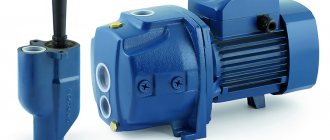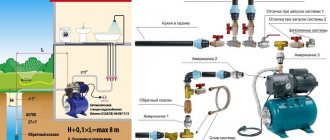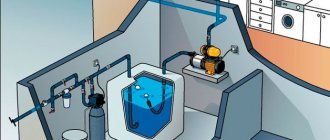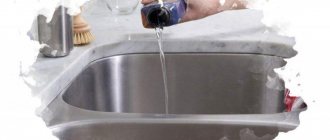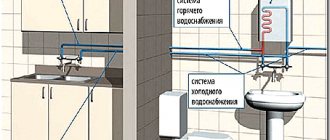Living conditions in a private cottage are very different from urban ones. There is no noise from public transport, no large number of residents rushing to work every morning and home in the evening. But there are other difficulties that have to be solved constantly.
One of the main tasks is wastewater disposal. After all, a modern private home has a bath and shower, a sink in the kitchen, one or more bathrooms, a washing machine. And all these benefits of civilization require a properly constructed sewer system.
The amount of wastewater coming from them is difficult to fit into a standard pit. But there is one more nuance - according to regulatory requirements, it must be absolutely sealed, since draining into the soil will lead to the destruction of the environment. There are several acceptable options for equipping waste systems. Of these, the most convenient and effective is the installation of a mini pump station in the house.
Purpose of a pumping station for a private house
Home sewage pump design
A sewer pumping station for a private home is an additional device that consumes electricity, so residents try to install gravity-flow systems so as not to pay extra. This is possible in cases where the septic tank is located below the house, and the pipes can be laid at a slope, since the length of the main line is short.
If for some reason the sewage pit is located higher than the house, the waste will not be able to flow on its own. The bathroom may be located in the basement, so the drains must first be raised, and then they will flow into the main pipe and then flow on their own. The same situation occurs when there is an obstacle in the way of sewer pipes. The close location of groundwater does not allow the required slope to be maintained, so the section of the highway is forced to be located vertically. In all these cases, it is necessary to create increased pressure so that the liquid does not stagnate in the pipes. In winter, this can lead to the formation of an ice plug and the sewer system will become impossible to use.
Wastewater contains large particles, which, at low speeds of movement, accumulate in the pipe and block it. This happens in areas where the highway turns or its diameter changes. In difficult terrain, it is difficult to lay pipes in a straight line - you have to go around buildings or obstacles.
Modular pumping stations. Main advantages
Modular pumping stations (PSS) are popular in the construction of modern private houses. They are convenient during installation, as well as during further operation.
Advantages of modular pumping stations:
- The modular pump station is entirely manufactured in production. This design reduces the time required for installation.
- The body is usually made of plastic with glass elements, into which a reinforced structure is placed. The rigidity of this material is very high, while the weight remains low. Because of these indicators, modular pumping stations are very easy to transport and install.
- The manufacturer places all the necessary equipment inside the modular pumping station. This provides space savings and additional ease of use.
- Modular systems involve the installation of more powerful pumps, which are produced using modern technology. Electricity consumption of these devices is reduced, but this indicator does not affect the power in any way.
- Together with stations of this type, special control panels are installed that allow you to control the system remotely.
Operating principle and main components
SPS forcibly transports wastewater to the septic tank
Sewage pumping stations can be divided into domestic and industrial. Industrial devices are complex engineering equipment that makes no sense to install in home systems, since their productivity far exceeds the volume of a private home.
For private buildings, units of medium complexity are provided. They are small and compact in size. The type of waste is taken into account - waste from the toilet containing large particles, kitchen waste and waste from the washing machine usually enter the home sewer.
The CNS consists of the following main components:
- a pump or several units of a similar type;
- storage tank.
The pump can be installed directly at the exit of the house or behind the toilet. These mini models have a neat appearance and fit well into the interior of the bathroom.
The storage tank can be compact in size or designed for an entire multi-storey building or even a village.
The operating principle is as follows: the liquid coming from plumbing fixtures is collected in a storage tank. When a certain level is reached, one or more pumps are activated and discharge waste into the sewer pipes. The process is automated, so there is no need to constantly turn on the equipment.
The pipes are equipped with check valves to prevent odors and liquids from getting back into the house. Garbage is retained in the receiving basket, from where it is removed during maintenance and routine cleaning.
The station can operate in three modes:
- at normal times, when the amount of waste does not exceed the norm, one pump is activated;
- during rush hour, when all residents of the house use water, both pumps or all units located inside the storage tank are turned on;
- emergency mode - in the event of a large amount of water entering or both units failing, a warning signal is activated indicating that the station cannot cope with the load.
Manual control is also possible, in which the pumping equipment is started by pressing a button.
Device Features
The pumping station scheme is selected taking into account the throughput of the treatment system, the composition of the wastewater, the depth of the supply collector, and the features of the terrain. Models of pumping stations are available with a vertical, horizontal casing arrangement and in a multi-casing design. The height (length) and diameter vary depending on the performance of the pump station. The pump, auxiliary equipment, and pipeline fittings are assembled inside. The latter, depending on the configuration, may consist of plastic pipes of different diameters, a check valve, fittings, flanges, couplings, O-rings, and adapters.
The materials used to manufacture body parts are usually durable and relatively inexpensive polymer and composite materials. The design of the SNS body is characterized by precision manufacturing, fairly high strength (wall thickness of at least 7-8 mm), increased rigidity (special reinforcing spherical elements, massive stiffening ribs). Due to these design features, the installation of SPS is usually carried out directly into the ground without the use of backfill with a sand-cement mixture.
An important element of the pumping station device is the pumping unit. It is this that ensures the forced supply of sewer or drainage wastewater under pressure to a height or into the collector pipeline. As a rule, submersible drainage or sewage pumps are used for this. They are characterized by low energy consumption. They are equipped with an automatic system (float sensor) that controls turning the pump on and off as the pumping station storage tank is filled (emptied).
Types of pumping stations for a private house
Mini devices are installed behind the toilet or at the exit from the house, from where the KNS pump pumps wastewater into the septic tank. This is a small device in a plastic case, discreet and low noise. It is based on submersible mechanisms with or without a cutting element.
The second type of KNS is larger and more powerful. It is a septic tank with a submersible pumping mechanism, which is turned on when it is necessary to clean the tank and direct the wastewater to the city sewer or sewer truck.
The third option is the most common. This is a stationary device equipped with 2 - 3 submersible pumps, which removes wastewater outside the house into a drainage pit. From there, using fecal units, the liquid is pumped into the next septic tank for filtration through the ground.
Scope of application of the domestic sewerage station KIT KNS - MINI
The KIT KNS - MINI household sewage pumping station is designed for pumping wastewater from sinks and toilet drains containing feces and toilet paper. It is used in toilets and washbasins installed in basements below the level of the sewer main, where it is impossible to organize the drainage of sewage water by gravity. KIT KNS-mini has 3 inlets, suitable for connecting a floor-standing toilet, washbasin and shower.
Advantages
A household sewage pumping station is a plastic tank equipped with a submersible pump, which is turned on using a hydrodynamic level switch when the tank is filled. The pump is equipped with a cutting mechanism and a receiving filter that crushes fibrous and solid inclusions (toilet paper). Due to this, drainage pipes have a small cross-section. The ventilation system of the unit is equipped with an automatically closing device that prevents overflow. The household sewage pumping station is small in size, attractive in design, fully equipped and ready for installation. The KIT KNS-mini pumping station will allow you to make the most of the space in your home, without sacrificing residential areas, creating a comfortable and cozy environment.
Technical characteristics of KIT KNS-MINI
| Specifications/Models | 5/7.40.0,4.220.SV-R | 5/7.40.0,37.220.SV-R (NEW) | 14/6.40.0,6.220.SV-R |
| Engine power, kW | 0,4 | 0,37 | 0,6 |
| Productivity, m³/h | >5 | 5 | 14 |
| Head, m | 7 | 7 | 6 |
| Efficiency, % | 66 | 66 | 66 |
| Weight, kg | 4,8 | 4,5 | 8,5 |
| Voltage, V | 220 ± 5% | 220 ± 5% | 220 ± 5% |
| Current frequency, Hz | 50 ± 5% | 50 ± 5% | 50 ± 5% |
| I nom, A | 2 | 2 | 3 |
| Rotation speed, rpm | 2900 | 2900 | 2900 |
| Heat resistance class | F | F | F |
| Salvo release | up to 1 l/s | up to 1 l/s | up to 1 l/s |
| Ambient temperature | no more than +25 °С | no more than +25 °С | no more than +25 °С |
| Temperature of the pumped liquid | no more than +80 °С | no more than +80 °С | no more than +80 °С |
| Rated current | 0.5 A | 0.5 A | 0.5 A |
Guarantee
The warranty period is 12 months from the date of sale of the equipment. Warranty obligations do not apply to products in the following cases:
- unauthorized (outside the service center) opening or repair of the pumping unit;
- failure of the electric motor due to improper connection to the electrical network;
- failure of the electric motor due to a failure or voltage drop in the electrical network;
- mechanical damage to the power cable (deformation, bending, soldering, etc.);
- in case of mechanical damage to the product or foreign objects entering the pumping unit causing the product to break down, the warranty is void;
- other conditions of operational disruption.
Criterias of choice
To drain drainage fluid from the house, a small stationary model is installed. Its power should be comparable to the number of points of water use - bathroom, toilet, washing machine or dishwasher, sinks, swimming pool or sauna. Select according to the parameters of power and volume of the storage tank. It is better if the pump station is equipped with two pumps.
To operate the sewer system of a multi-story building, you will need a large storage tank and several units that will pump out the liquid. An important point is the presence of a cutting mechanism. It is better when there is one, since debris and large waste can clog the outlet pipe.
Details
Types of pumping stations for the home. Compact devices are placed behind the toilet, or near the exit from the room, they pump waste water into the septic tank. The device is a device in a plastic housing that operates silently. They consist of a submersible mechanism, sometimes equipped with whining elements. Larger SPS have high power. They include a septic tank equipped with a submersible pump. It works. When a tank needs to be cleaned, it is either necessary to redirect the sewage to a common pipeline or to a special sewage disposal vehicle.
The most common option is a permanently installed device. It has two or three submersible pumps. With their help, wastewater goes beyond the territory of the house into a sump. Using a fecal pump, wastewater is pumped into another septic tank to be filtered through the soil.
How to choose equipment
If it is necessary to drain water from a living space, then install a small model. It must have enough power to use water from all points, including the toilet, sink, bathtub, washing machine, bathhouse, etc. The storage tank is also selected according to power and volume. It is recommended to choose a station with 2 pumps.
To service a multi-story building, you need to have a large storage tank, as well as several pumping devices for pumping out wastewater. It is important that the pumps have cutting elements in order to crush large inclusions in the waste and not clog the pipe.
How to calculate parameters
When buying a pumping station, you do not need to purchase an expensive device. You need to rely on the following parameters:
1.The size of the device must be suitable for the house it will serve. In a private house, you need to install a household device that will fit on one square meter.
2.volume of wastewater that is expected to be processed. The parameter depends on the number of people who live in the house.
3. distance of the house from the septic tank.
4.height level of the pipe that sucks in and discharges wastewater.
5. level of productivity, which depends on the quality of wastewater and its contamination.
Attention! You can install a compact station for your home yourself. Large stations consist of several parts that are designed to work in specific conditions.
Carrying out calculations
When purchasing a complete SPS, there is no need to buy a very expensive device that will operate at 10% of the declared power. A station is selected based on the following indicators:
- dimensions of the equipment - must be suitable for the room in which installation is planned; for a private house it will be an ordinary household appliance that can be placed on an area of 1 sq. m;
- expected flow of waste liquid - depends on the number of residents and the volume of water consumed during rush hour;
- the distance to which the liquid must be removed;
- height of inlet and outlet pipes;
- equipment performance based on the degree of wastewater pollution.
A household SPS can be connected independently, while large-sized devices are formed from several parts designed for specific operating conditions.
Purpose and design
The main purpose of the stations is to lift wastewater to treatment facilities located above the discharge point, as well as to ensure the supply and pressure of discharged water in accordance with the specified parameters under normal conditions and in the event of an emergency.
The body of the pumping station is made of concrete or concrete rings; modern devices are made of polypropylene or fiberglass. Inside the case there are:
- coarse filters;
- pump;
- liquid level sensors with a pump operation monitoring system;
- inlet and outlet pipelines;
- shut-off valves (taps, valves).
For stations with high power, staircases and maintenance platforms are provided. The hull itself is equipped with a hatch on top.
Installation features
You can install and connect household water pumping stations following the instructions. These are “sololifts”, which are placed near plumbing fixtures. They are compact and do not require special skills. The instructions indicate step by step the actions that need to be performed.
Another thing is to install a sewer station for a country house. For these works it is better to invite professional craftsmen. Accuracy and correct selection of components, as well as their final configuration, are important here. The sequence of actions is also important. A person who does not have experience and does not understand the nuances of devices will not be able to carry out installation correctly and will lose the manufacturer’s warranty.
Operation and Maintenance
Maintenance of household stations located in the house should be carried out regularly. The pump may become clogged if it is not equipped with cutting blades. The work is performed by a service center specialist. If you carefully observe its actions, you will later be able to inspect and clean the unit yourself.
The water pumping station of a private house also requires regular maintenance, but it is prohibited to go down into the wastewater tank yourself. Poisonous gases can cause loss of consciousness and death from asphyxiation.
Advantages and disadvantages of CNS
The advantage of SPS is that it improves the operation of the entire sewer system, eliminating odors and preventing the reverse movement of wastewater. At the same time, the equipment requires frequent maintenance, which requires financial investments.
Prices for sewage pumping systems are high. The cost of the device depends on the brand of the manufacturer, the materials from which the main components are made, as well as the complexity of the design. Properly installed equipment lasts about 10 years. Cheaper devices from unknown manufacturers are much smaller.
The most popular models of sewage pumping stations
You can find units from various manufacturers on sale, but models from several brands are in greatest demand.
Calpeda
Domestic sewer pumping station Calpeda
Domestic sewer pumping station Calpeda belongs to the budget price segment, its cost is only 16 thousand rubles. At the same time, it is capable of pumping 240 cubic meters of wastewater within an hour, and the maximum pressure reaches 48 meters.
The unit is economical (consumes only 500 W of electricity) and highly reliable. The simple design allows you to install it and connect it to the network even yourself. When choosing such a model, you should remember that it is designed to work with wastewater whose temperature does not exceed 40 degrees.
Grundfos
Pumping units of this company are widely used in various fields.
Leading experts advise paying attention to the following models produced by this manufacturer:
Sewage installation Grundfos Sololift 2
- The Grundfos Sololift sewer station is perhaps one of the most popular pump models for the home. It is distinguished by its small overall dimensions, can be installed directly behind the toilet, and at the same time provides drainage from the washbasin or bathtub (but the temperature of the liquid should also not exceed 40 degrees).
The maximum generated pressure reaches 10 meters, while the storage tank is equipped with a filter system that prevents sewage odors from penetrating into the room. The IP 44 protection class of the unit allows it to be installed directly in rooms with high humidity. Such an installation costs about 24 thousand rubles.
- The Grundfos Sololift 2 household pumping unit is compact in size and light in weight (only 4.5-7.5 kg). The unit has a throughput capacity of 185 liters per minute, which is quite enough to meet all household needs. The pump is capable of working with wastewater at temperatures up to 50 degrees, the maximum pressure reaches 8.5 meters vertically. It is possible to operate in automatic mode; the unit is turned on when a certain volume of wastewater has accumulated.
- To ensure the pumping of large quantities of wastewater, the Grundfos Multilift sewer station is recommended; it is successfully used in office premises, retail establishments, restaurants, and public buildings. The unit is capable of pumping more than 50 cubic meters of juice per hour, the lifting height of the wastewater reaches 19.5 meters. Depending on the modification, power consumption can reach 4.5 kW, while the installation is not designed to work with hot waste water (the maximum temperature should not exceed 35 degrees). The cost of pumps of this type starts from 90 thousand rubles.
- The Grundfos Conlift sewage pump, which can be used for pumping condensate from heating devices and air conditioners, is one of the inexpensive ones. The cost of the unit is only 4-5 thousand rubles (depending on the modification), although its productivity is appropriate, only 650 liters per hour. The device can be used as a submersible pump at depths of up to 5.5 meters. The installation is distinguished by the presence of thermal protection and a check valve.
Unipump Sanivort 250
Sewage pumping station for the kitchen UNIPUMP SANIVORT 250
Sewage pumping station for the kitchen UNIPUMP SANIVORT 250 also belongs to the budget price category (cost from 6 thousand rubles). The installation provides pumping of about 5 cubic meters of wastewater per hour, while it is capable of lifting it up to 5 meters vertically, and the horizontal supply reaches 50 meters.
It features minimal energy consumption (0.25 kW) and is equipped with a pressure sensor that ensures automatic operation. The installation is recommended for use in conjunction with dishwashers and washing machines; it ensures drainage of wastewater when it is not possible to install gravity systems.
Wilo-Drainlift
Industrial sewer pump WILO-DRAINLIFT KN 32
The industrial sewer pump WILO-DRAINLIFT is also successfully used for domestic purposes. Its durability is ensured by the use of main working units made of stainless steel. The unit can be used for pumping out fairly hot wastewater (temperatures up to 50 degrees), and its cost is quite affordable (from 2 thousand rubles, depending on the modification).
A significant operating life of the unit is ensured thanks to the built-in overload protection system; in addition, the unit is distinguished by a sealed housing with protection class IP 20.

